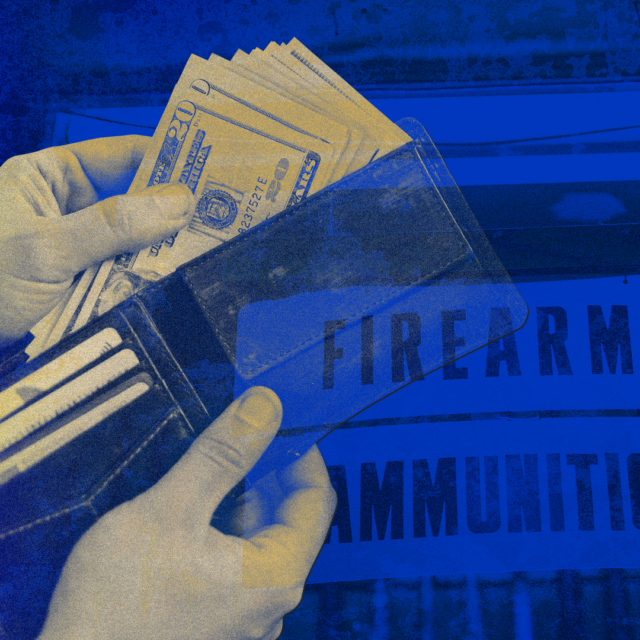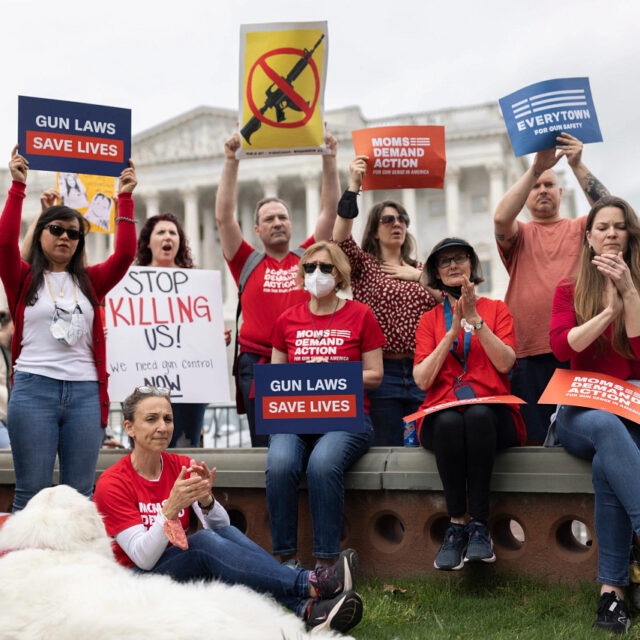H.R. 1236: A Comprehensive Approach to Extreme Risk Laws
Learn More:

Summary
The Extreme Risk Protection Order Act of 2019 (H.R. 1236) helps prevent gun violence tragedies by empowering family members and law enforcement across the country to intervene when a person is in crisis and poses a danger to themselves or others—while protecting due process rights of all involved. This bill supports the states that have passed Extreme Risk (or “Red Flag”) laws, encourage additional states to pass strong Extreme Risk laws, and establish a strong federal Extreme Risk process that can be used in federal courts in all fifty states.
H.R. 1236 would strengthen and expand the tools to act on warning signs before they escalate into tragedy.
H.R. 1236 establishes a federal grant program for states that have Extreme Risk laws with legal standards substantially similar to those described in the bill. The grant funding could be used by states to train law enforcement and court personnel on Extreme Risk laws, develop protocols for enforcement of orders, and raise public awareness of this life-saving process.
H.R. 1236 would also empower federal courts to issue Extreme Risk orders. The legislation establishes clear legal standards for when a federal order could be issued including strong due process protections, and it would give family members and law enforcement in all fifty states a path to take action when they observe someone in crisis.
Extreme Risk laws create an opportunity to intervene before threats turn deadly, and the standards in H.R. 1236 includes robust due process protections.
When a person is in crisis, loved ones and law enforcement are often the first to see signs that they pose a threat. An Extreme Risk law allows them to petition a court for an Extreme Risk Protection order to temporarily remove guns from dangerous situations and prohibit the purchase or possession of firearms while the order is in effect.
An order may only be issued if a judge finds that there is evidence proving that the person poses a significant danger of injuring themselves or others with a firearm.
- A judge can issue a short-term emergency order before a full hearing is held, but only upon finding there is evidence of imminent danger that is likely to occur before a full hearing can be held. Under H.R. 3076, this order lasts only 14 days.
- The final order, generally lasting up to one year (180 days for the federal order), can be issued only following a full hearing for which all parties are given notice and the opportunity to present and respond to evidence. The judge then determines if the evidence presented meets the burden of proof and may issue an Extreme Risk order.
These orders are temporary civil court orders and firearms are returned when the order expires. Extreme Risk laws include provisions to deter people from falsely or maliciously seeking an order.
Nineteen states and the District of Columbia have passed Extreme Risk laws.1CA, CO, CT, DE, DC, FL, HI, IL, IN, MD, MA, NV, NJ, NM, NY, OR, RI, VT, VA and WA.
Twelve states and the District of Columbia have passed Extreme Risk laws since the shooting in Parkland, including five laws signed by Republican governors.2CO, DE, FL, HI, IL, MD, MA, NV, NJ, NY, RI, VT passed laws, with FL, IL, MD, MA and VT having Republican governors.
Data collected from 10 states with Extreme Risk laws shows that 3,900 Extreme Risk petitions were filed between January 2018 and August 2019, and that the filings were spread across the counties in those states.
Perpetrators of mass shootings and school shootings often display warning signs before committing violent acts.
In 51 percent of mass shootings from 2009 to 2017, the attacker exhibited warning signs before the shooting.3Everytown for Gun Safety. Mass Shootings in the United States: 2009-2017. https://every.tw/1XVAmcc. December 2018. For example, before killing six people in Isla Vista, California in May 2014, the shooter made homicidal and suicidal threats, and his parents alerted law enforcement. But, there was nothing they could legally do to remove his firearms.4Pickert K. Mental-health lessons emerge from Isla Vista slayings. Time. May 27, 2014. https://goo.gl/UL5jLX.
The U.S. Secret Service and the U.S. Department of Education studied targeted school violence incidents and found behavioral warning signs that caused others to be concerned in 93 percent of cases. They also found that in 81 percent of incidents, other people, most often peers, had some type of knowledge about the shooter’s plans.5United States Secret Service and United States Department of Education. Prior knowledge of potential school-based violence: information students learn may prevent a targeted attack. https://bit.ly/2MPrOoL. May 2008. For example, the shooter who killed 17 people and injured 17 others in Parkland, Florida in February 2018 had been expelled from school, and students and teachers reported he displayed threatening behavior. His mother had repeatedly contacted law enforcement.6Marjory Stoneman Douglas High School Public Safety Commission. Initial Report Submitted to the Governor, Speaker of the House of Representatives and Senate President. http://www.fdle.state.fl.us/MSDHS/CommissionReport.pdf. January 2, 2019.
Interventions in states with Extreme Risk laws have prevented potential mass shootings.
California’s Extreme Risk law has been used in 21 cases as part of efforts to prevent mass shootings. In those cases, fifty-two firearms were recovered and there have been no mass shootings, other homicides, or suicides by persons subject to the orders.7Wintemute GJ, Pear VA, Schleimer JP, Pallin R, Sohl S, Kravitz-Wirtz N, et al. Extreme Risk Protection Orders Intended to Prevent Mass Shootings: A Case Series. Ann Intern Med. [Epub ahead of print 20 August 2019] doi: 10.7326/M19-2162.
Reports from Maryland,8Broadwater L. Sheriff: Maryland’s ‘red flag’ law prompted gun seizures after four ‘significant threats’ against schools. The Baltimore Sun. January 15, 2019. https://web.archive.org/web/20190116044427/https://www.baltimoresun.com/news/maryland/politics/bs-md-red-flag-update-20190115-story.html. Florida,9Kennedy E. Tate student’s AR-15, father’s 54 guns removed under new red flag law. Pensacola News Journal. July 9, 2018. https://bit.ly/2UHmaba; Lipscomb J. Florida’s post-Parkland “Red Flag” law has taken guns from dozens of dangerous people. Miami New Times. August 7, 2018. https://bit.ly/2ORW56U. and Washington10Correspondence with Christopher Anderson, director of the Domestic Violence Unit of the Seattle City Attorney’s Office. show that Extreme Risk laws are being used effectively to avert instances of potential school violence.
Extreme Risk laws address another American gun violence epidemic—firearm suicide.
Nearly two-thirds of gun deaths in America are suicides, with over 22,000 deaths a year, including 1,000 children and teens.11Centers for Disease Control and Prevention. National Center for Injury Prevention and Control, Web-based Injury Statistics Query and Reporting System (WISQARS) Fatal Injury Reports. A yearly average was developed using five years of most recent available data: 2013 to 2017. Children and teens are defined as ages 0 to 19. Blocking a suicidal person’s access to a gun can save their life. Nearly nine out of ten suicide attempts with a gun result in death. By contrast, most people survive suicide attempts by other means—and don’t go on to die by suicide.12Owens D, Horrocks J, and House A. Fatal and non-fatal repetition of self-harm: systematic review. British Journal of Psychiatry. 2002;181:193-199.
Connecticut’s increased enforcement of its Extreme Risk law was associated with a 14 percent reduction in the state’s firearm suicide rate, and in the 10 years after Indiana passed its Extreme Risk law in 2005, the state’s firearm suicide rate decreased by 7.5 percent.13Kivisto AJ, Phalen PL. Effects of risk-based firearm seizure laws in Connecticut and Indiana on suicide rates, 1981-2015. Psychiatric Services. 2018; 69(8): 855-862; Swanson JW, Norko M, Lin H, et al. Implementation and effectiveness of Connecticut’s risk-based gun removal law: Does it prevent suicides? Law and Contemporary Problems. 2017; 80: 179-208.



